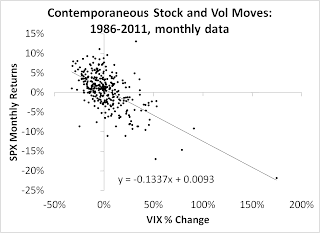It sure would have helped if sites like
lowvolatilitystocks.com were up back in 2007. It's Bob Haugen and Nardin Baker's new website and has lots of neat references on low volatility. Then there's a wikipedia page on the
Low_volatility_anomaly, where I get to discover first hand how misleading Wikipedia is when you are well versed in something. Nonetheless, the Wiki page is pretty good and hopefully will get better over time.
In my Kafkaesque
litigation I scrambled to find simple evidence of common knowledge, which would be exempt from confidentiality agreement that my old boss was using to keep me from starting a new low-vol fund. It was easy for me to deflect the 'mean variance optimization' allegation by pointing to Nobel Prize winning research even a judge could apprehend, but the low volatility angle was a lot harder to prove, at least by the time I would run out of money. Not only was I too soon pitching this strategy on Wall Street (back in
the 1990s), but I was too soon involved in its litigation (circa 2007), as these webcites would have made my life easier. Yet, I think it's misleading to say low volatility investing was 'out there' in 1975 (Haugen and Heins). As someone who worked every day on the issue of precedence for over a year, I can tell you it was hardly common knowledge or obvious that these early works implied low vol investing was a good idea, and so instead I was emphasizing my prior use (eg, my
dissertation and
fund I had run with an explicit low vol focus).
There were lots of papers that had found the CAPM didn't work, in that higher risk stocks didn't outperform lower risk stocks. In 1993, a year after the famous Fama-French CAPM-rejecting three factor model was introduced, Stephen Ross noted as if it was conventional wisdom that in practice “the long-run average return on the stock, however, will not be higher or lower simply because it has a higher or lower beta”[in “Is Beta Useful?” In The CAPM Controversy: Policy and Strategy Implications for Investment Management]. It was like in
The Emporer's New Clothes, where once admitted by Fama--one of the CAPM's founding fathers--that the CAPM didn't work, every supposedly knew it didn't work all along (eg,
Gibbons and
Shanken rejected it at the 0.1% level in the 80's. Then there's Bruce Lehman in 1990 who
had noted the absence of any residual risk premium suggested this puzzle was nontrivial.). With hindsight, these findings obviously implied the superiority of low volatility investing, because they imply you get the same return for less volatility/beta.
Yet to say everyone knew about low vol investing because of Haugen and Heins (1975), or Haugen and Baker (1991) forgets that this was just part of all those CAPM rejection pieces, which until 1992 everyone thought meant something quite different (swamped by value, size, or methodological issues). Certainly not that low vol investing is attractive, which to my knowledge was not mentioned until Ed Miller, who stated,
in a 2001 Journal, that "An implication of [my winner's curse] theory] is that investors can improve their return relative to risk by exploiting the flatness of the security market line."
Anyway, if we are merely to look for old references of the inverse risk/return relation in journals, I suppose we should start with
Soldofsky and Miller's 1969 JoF paper, which clearly showed a perverse risk-return relation, and this observation was mentioned by later published articles that picked up on this finding,
Richard McEnally (1974) and
Ed Miller (1977). Everyone can go back because that's what academics do, cite prior work. I suppose there's something in Aristotle, and surely the Bard had a few quips ('Methinks thy risk premiumme ys not forsooth!').
What's really fun if you read these empirical pieces from prior to computers (ie,pre-1980), is how really shoddy they all are. The biases are too numerous to mention (survivorship bias, ignoring delisting returns, compounding daily returns, etc.). In presentation they tend to bury the lede, saying what they looked at and why, but not what they found. Lastly they are all sure to state 'further empirical study is needed' in the conclusion, the "
Carthago delenda est" of the times. No wonder macro models failed relative to simple vector autoregressions in the 1970s, econometricians were like medieval doctors back then.













